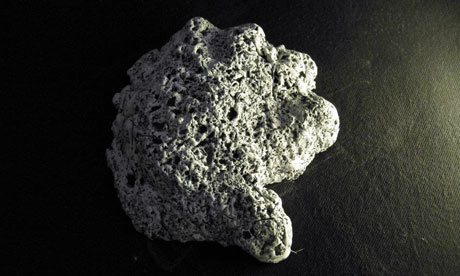
Last month’s expedition in the jungles of Sumatra yielded some interesting evidence in the search for the small-stature Orang Pendek or “Short man”. Richard Freeman writes about his experiences in the jungles of Sumatra on this post in the Guardian. What’s interesting is that they’ve collected unknown hair samples and possibly, what could be an Orang Pendek hand print. The team was also able to get details on recent encounters between the locals and the Orang Pendek:
“…He described it as around three feet tall but with massive shoulders and chest. He pointed to a piece of washing on a line to
indicate the colour of its hair – a mid-tan. It had an ape-like face and walked upright on two legs while swinging its arms. Upon noticing Pak Entis it became alarmed and raised its hands above its head uttering a “hoo-hoo” sound and moved quickly away…”
With more and more expeditions heading out into the Sumatran wildlife, do you think that we are closer to finding an answer as to what exactly is this thing the people call “Short man” ?
1 commentEven in this age of satellite mapping and global positioning, there remain “lost worlds” where few humans tread and where species of animal unrecognised by science live. Kerinci Seblat National Park in West Sumatra is one such place. The size of a small country, its dim, steamy interior has never been explored properly. Last month I returned to these jungles for the fourth time to track an elusive and, as yet, unrecorded species of ape known to the locals as the orang pendek or “short man”.
This year’s expedition was the largest of its kind ever to visit the area. It consisted of two teams. The first, made up of Adam Davies (expedition leader at the Centre for Fortean Zoology), Dave Archer, Andrew Sanderson and myself, would concentrate on the highland jungles around Lake Gunung Tujuh. The second team, consisting of Dr Chris Clark, Lisa Malam, Rebecca Lang, Mike Williams, Jon McGowan and Tim De Frel would have their base in the “garden” area – the more open, semi-cultivated land that abuts onto the true forest. According to local reports, the creature has been sighted here on a number of occasions when it comes down to raid crops such as sugar cane.
Before team one left, our guide Sahar introduced us to an eyewitness called Pak Entis, who claims to have seen an orang pendek in the garden area in April. He described it as around three feet tall but with massive shoulders and chest. He pointed to a piece of washing on a line to indicate the colour of its hair – a mid-tan. It had an ape-like face and walked upright on two legs while swinging its arms. Upon noticing Pak Entis it became alarmed and raised its hands above its head uttering a “hoo-hoo” sound and moved quickly away. It was in view for around a minute.
We climbed the jungle-swathed lip of Lake Gunung Tujuh, the caldera of an extinct volcano, and crossed by canoe. After setting up camp we began trekking into the jungle. Generally, we would trek for several miles and then stop and have long sessions of quiet observation.
We also set up motion-sensitive camera traps. We found chewed ginger plants and rattan shoots, both thought to be favourite foods of the orang pendek. DNA has never been recovered from samples like this, unfortunately, and these had been exposed to the rain for quite some time.
On one trek, on the far side of the lake – an area with damper, thicker jungle – Sahar’s brother John found a print next to a rotting log that had been ripped apart. Orang pendek have been seen feeding off grubs in such logs. The print was cast by Andrew Sanderson using quick-drying dental plaster. Close by, Sahar found a number of hairs, which Adam preserved in ethanol for later laboratory analysis.
Read More: Guardian UK




